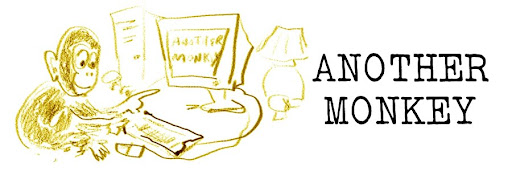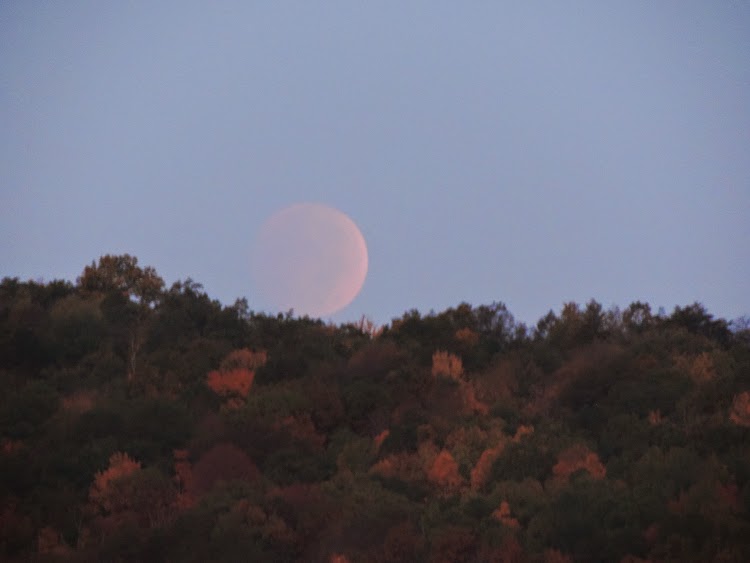I was going to post this on my Lunar photography blog, Shoot the Moon, but then I decided it would be more appropriate to post it here and link to it from there.
I woke up extra-early on the morning of October 8, 2014. The weather forecast had not been promising the night before, and clouds had been thundering across the face of he Full Moon when I went to sleep a few hours earlier. Still, I dragged myself out of bed, took a shower, made coffee, ate some breakfast, and took a peek outside to see if I could see anything. A red glow in the West suggested that if nothing else, I might get some interesting cloud photographs. I made my lunch, gathered up my gear, walked down to the car, and headed for the Nanticoke-West Nanticoke bridge, where I would have a pretty good view of the Western sky - and maybe the eclipsed Moon.
Threading my way through the pre-dawn traffic in Nanticoke, including taking a detour caused by an ambulance parked outside of the local senior high-rise, I caught occasional glimpses of the Moon. The first seemed shrouded in clouds, but those that followed appeared to be clearer. I parked in the semi-paved lot on the Naticoke side of the bridge, grabbed my coat, a hat, my tripod, and a camera, and walked out until I was over the Susquehanna river.
6:26 AM: The Moon was there! Clouds darted around it, but I could see it.
6:31 AM: My camera was having a hard time focusing on a low-light target at infinity. I played with the settings a bit and realized that the standard Landscape mode would work best in this situation - but only once the eclipse had reached totality. Before then, everything was an unfocused blur. After totality, the Moon brightens up a bit, usually. (There was one that I remember from sometime in the late 1980's when the Moon actually became a dark purplish shade, and hung in the sky like a burned-out cinder. Through binoculars it looked ridiculously three-dimensional, like it was a ball hanging just out of reach.) Clouds were still present, but I decided they added a nice touch.
6:32 AM: I was on the walkway of the bridge, which is several feet wide and separated from the automobile traffic by a thigh-high guardrail. I had my tripod positioned so two of the three legs were touching the guardrail. Even in the hour preceding sunrise there was still quite a bit of traffic on the bridge. In this image, a car drove by just as the shutter opened. The reflected sodium vapor lights on the bridge created an eclipse-colored blur.
6:32 AM.
6:32 AM.
6:34 AM: I tried to establish context for these photos by pulling back to include the nearby disused railroad bridge. The camera did not take kindly to the change of state and lost focus.
The clouds settled in for a bit. I took a few more shots and got some fuzzy images. After a few minutes I heard and felt someone approaching on the bridge from the Nanticoke side. I was wearing a black longcoat but had made sure I was wearing relatively light-colored jeans and a beige baseball cap for contrast and increased visibility. I moved against the guardrail, pressed my tripod against it, and eyed the stranger warily: A stocky redbearded fellow, mid-30's, appeared somewhat unkempt. Could be some homeless guy, could be someone out for a morning constitutional. Could be someone who would want to steal my $400 camera and $30 tripod and sell them for enough money to get his next fix and maybe the one after that.
"Morning," he said.
"Morning," I grunted back.
He walked past silently, then stopped and looked at my setup. "Whatchu lookin' at?" he asked, looking at the Western horizon.
"The Moon," I said. "Lunar eclipse. Snedeker's been going on about it all week." Joe Snedeker is a local meteorologist whose TV forecasts involve more clowning than actual weather information. But he had actually been talking extensively about the eclipse for most of the last week.
"I don't see it," the stranger said.
"It's - " I looked towards the horizon and the Moon was mostly hidden by clouds. "Aw, heck," I said, and hit the playback button on the camera. I had to go back a bit to find a decent photo. "Here," I said.
"Huh. That's pretty neat," the stranger said. "Well, have a nice day." He resumed his walk across the bridge.
6:43 AM: Nine minutes after the last shot the clouds cleared out for a while. The Moon was now much lower but the context was much easier to capture. Many outlets had been referring to this dramatically as a "Blood Moon" - apparently, that's another term for a total lunar eclipse. Despite the hype, I found this one had a rose-pink hue.
6:44 AM: I zoomed in a bit to capture the Moon as it sank closer to the treetops.
6:46 AM: The "Moon Illusion" in a photo. I pushed my zoom all the way to capture the dawn-faded and mist-shaded eclipsed Moon full size, and then I decided that wasn't a very interesting image. I backed off a bit and dipped the camera to include the trees. Reviewing this picture later I thought "My God, the Moon is HUGE there." It's not. I routinely take pictures of the Moon that fill much more of the image. But in this one you are clearly seeing foreground objects - trees that are less than half a mile away - and you're looking at the Moon in terms of them. Trees are big; the Moon is bigger than trees!
6:46 AM: Clearly, the end was near. The Moon was still well above the horizon, but about to pass below a local obstruction that would block it from view. Fun fact: by this point the Moon might have been much lower on the horizon, but its image was refracted up by the atmosphere. This can - and did - result in a condition called a selenelion, a situation where the setting Full Moon and the rising Sun are 180 degrees apart but both appear in the sky at the same time, due to both of their images being refracted above the horizon.
6:47 AM: Going...
6:47 AM: ...going...
6:48 AM: ...going...
6:48 AM: ...going...
6:48 AM: ...going...
6:48 AM: ...OK, we're gonna call it "gone" and move along.
So that was the end of the eclipse for me. Well, I thought I was seeing a bizarre atmospheric effect as the Moon began to peek up over the treetops again, much larger than it had been before. But this turned out to just be a cloud.
And there I was, with a tripod and a camera on a bridge over a river, on a crisp Autumn morning with the Sun rising in the east and some time to kill before I had to head to work. So I hiked out farther onto the bridge to get a better look at the Eastern sky.
I saw this:
6:50 AM: These beams are crepuscular rays - think of them as anti-sunbeams, shadows cast by clouds on the water vapor in the atmosphere.
6:52 AM: The crepuscular rays were strong and clear. A friend in Williamsport got almost the same images, so atmospheric conditions were similar across the area.
6:52 AM.
6:55 AM: Some of the gold-rose hue is leaving the horizon. The Sun will soon clear the trees, but that will be fundamentally uninteresting. Plus, I knew I should head home, review my images, and get to work.
As I walked back towards my car I realized that with such strong, clear crepuscular rays, I might be able to see the rarer phenomenon of anticrepuscular rays, shadows cast by clouds that stretch across the sky and converge on the antisolar point - creating a "dark Sun setting" effect. I turned to the West toward the railroad bridge that had given some context to my images, and...
6:58 AM: Yep.
6:58 AM: Exactly as expected.
I walked back to my car, went home, and got ready to head to work.












































1 comment:
beautiful pictures, i looked at them twice and read all the narrative, i have always admired how eloquent you are Har!
Heres looking forward to Pealr Harbor Day!
Post a Comment